Everyone who owns a turtle tank wants it to look pristine, well-kept, and without any cloudiness on the glass. Unfortunately, whether you are a new turtle owner or have had one for years, it’s likely at some point of your ownership you have experienced cloudy water.
This can be an anxiety-inducing experience for many turtle keepers. Fortunately, it’s not as complicated as it seems and there is a simple and logical way of looking at why your tank might be cloudy and how to fix it. In this article, we will take a look at some of the possible reasons why your turtle tank may be cloudy, and provide you with some solutions to take care of the issue!
What Causes Tank Cloudiness?
The first thing you need to figure out is what’s causing your tank to turn cloudy in the first place. There are three main culprits behind cloudiness: organic matter, bacterial blooms, and minerals. It is important to recognize the differences of each source as they require different remedies.
Organic Matter
Organic matter can refer to anything from fish food or turtle fecal matter that sinks to the bottom of your tank. This will decompose over time if not removed by siphoning, which creates organic compounds in your water. This is the most common reason for a tank turning cloudy due to naturally-occurring bacteria breaking down these compounds.
Here are the most common reasons why you have organic matter build-up that leads to cloudy water in your turtle tank:
- Not enough filtration
- Too many turtles
- Feeding too much
- Food is left on the bottom of the tank
- Feeding live food
- Other non-organic matter being introduced to the tank (i.e. substrate, fake plants)
Bacteria Blooms
Tank cloudiness can also be caused by bacterial blooms. A bacteria bloom happens when there is an overgrowth of the natural bacteria in your turtle environment. These bacteria are essential to keeping your turtle tank clean and healthy, but if they start multiplying too much, then the byproducts from the decomposition process can become overwhelming and turn your water cloudy.
The most common causes of bacterial blooms in a turtle tank leading to cloudy water are:
- Not enough filtration
- Too much light
- High water temperature
- Poor surface agitation
- Not changing the filter media often enough
Mineral Deposits
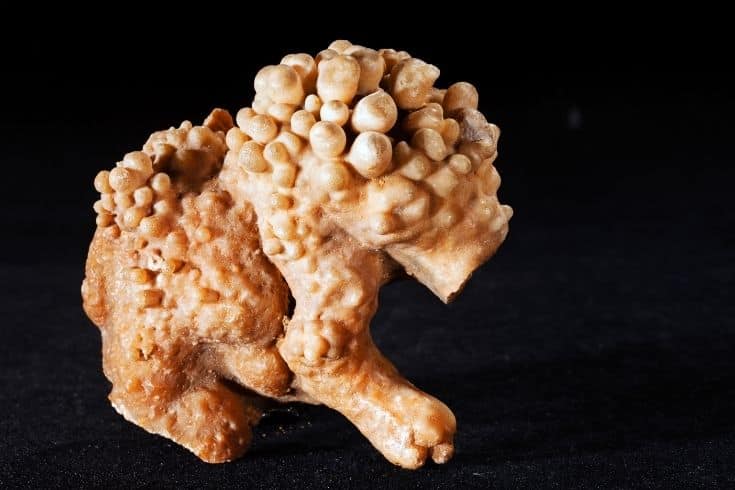
Mineral deposits refer to the build-up of minerals inside your tank after the water evaporates. This is why your tank may turn cloudy right around the time you do a water change, as there will be more exposed mineral matter after adding fresh water. These minerals are not harmful and do not pose a threat to fish or turtles, but they can cause your tank to look hazy.
The most common causes of cloudy water due to mineral deposits are:
- Adding salt to the tank
- Using hard water to top off your tank
- Not replacing evaporated water fast enough or often enough
Why Is My Turtle Tank Cloudy? – Common Issues and Solutions
Now that you have determined why your water is cloudy, it’s time to start fixing the issue. Read on for the steps you should take to clear up your turtle tank!
Not Enough Filtration
The most common cause of cloudy water is a lack of proper filtration. Be sure you are using an aquarium filter rated to handle the size tank and the number of turtles you have. A filter that is too small can result in poor water quality marked by unhealthy nitrate levels, ammonia levels, and nitrite levels. This can prove extremely harmful to your pet.
It is also important that you are changing out your filter media at least every month, if not every two weeks. If using a charcoal-based filtration system, be sure to replace the entire cartridge – never use half of it and refill with new carbon. This can lead to a build-up of carbon particles that will turn your water cloudy.
In general, we recommend canister filters because they are easier to clean and maintain than most other types of filters. Canisters can be taken apart easily for cleaning, removing the need to replace several filter media pads at once. Instead, you can clean the individual filters as needed.
Too Many Turtles
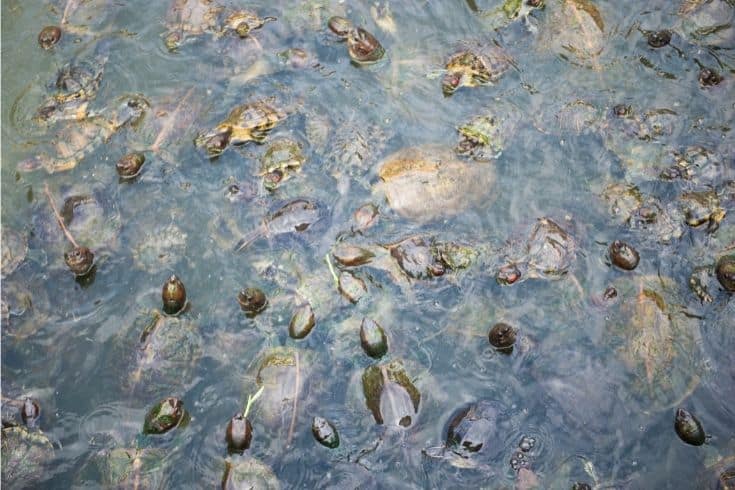
Another common cause of cloudy water is having too many turtles for your tank. You need to make sure you are accounting for the size and number of turtles before setting up a tank. If you have juvenile, female RES (possible future breeders), or sick turtles in an enclosure that is too small, then they may be producing more turtle waste than your filtration system can handle.
Therefore, you should make sure to research the turtle tank size you need for your turtle(s) before setting anything up. Take note of the size of your turtle(s) and if they are male or female, as these factors will impact tank size. If having too many turtles is what’s causing your water to turn cloudy, you will need to consider adding larger tanks to accommodate your aquatic turtles.
Remember, a tank that’s too small forces your turtles to inhabit a space with unhealthy filtration and water quality. Turtle waste, decaying food, dead plant matter, and other debris can lead to a dangerous buildup of toxic chemicals in your tank. Conduct a partial water change immediately, and make sure to upgrade your tank size in the future.
Feeding Too Much
One of the easiest ways you can cut down on your chances of having cloudy water and poor filtration is to feed less. If your turtles are feeding more than they need, then there will be leftover bits of food in the tank. This excess food will in turn cause a buildup of organic matter in your turtle tank that can end up turning your water cloudy.
To prevent this from happening, try cutting back on the amount you are feeding your turtles – do not go by what is listed on the package. Instead, feed them as much as they will eat within 20 minutes once or twice a day. If possible, use an automatic feeder so that you don’t overfeed your turtles when you are not home.
If you find yourself with a dirty turtle tank after every feeding session in spite of your best efforts, consider feeding your turtles in a separate container. That way, you can feed them as much as they will eat, and the remainder can be properly disposed of without attracting bad bacteria to your turtle tank.
Too Much Light
Have you ever seen green swimming pools? We bet it was quite an unpleasant sight! If your tank is receiving too much light, then your water can turn cloudy and green as a result. This is because excess light causes algae to grow in the water of your tank. This algae growth will lead to cloudy water, which can be harmful to turtles if it is allowed to get out of hand.
Not only does excess algae growth cause your water to take on a murky, cloudy appearance, it can also reduce the oxygen level in your tank. Over the course of a couple of weeks, this can end up killing your turtle(s) if not remedied – so you want to take action immediately.
To take care of the issue, you need to reduce the amount of light that is entering your enclosure. You can do so by covering parts or all of the tank with paper or fabric. This will cut down on how much light reaches inside your turtle tank and prevent algae growth, green water, and cloudy water conditions in your pet’s habitat.
Adding Too Much Salt To The Tank
Sometimes, you may be adding too much salt to your turtle tank. Although turtles need the electrolytes found in salt to function properly, they do not need them at levels drastically higher than what can naturally occur in their environment. Too much salt in a turtle tank can lead to mineral deposits, which can build up and turn the water cloudy.
In addition, excess salt can alter the biochemical properties of your aquarium water, resulting in the growth of algae and other microorganisms. You can avoid problems like this by checking with your water and/or turtle supply store before adding salt to your tank. The last thing you want to do is disrupt the biochemical processes in your turtle tank.
A good rule of thumb to avoid overdosing your turtles with salt is to never add salt to a turtle tank that is set up or has been running for less than two weeks. This is because newly-set up tanks have not had time for any of the excess minerals to flush out of the water. Give your turtle tank at least two weeks to “cycle” before adding any salt.
Using Hard Water To Top Off Your Tank
If your home’s tap water comes from a well or you live in an area with very hard water, then the water may be too high in minerals for your turtle to use safely. Hard water can cause mineral deposits to build up inside your turtle tank, which can turn the water cloudy.
To avoid this problem, use distilled or distilled or reverse osmosis (RO) filtered water when you need to top off your turtle tank. If you intend to use water from other sources, be sure to test them first to make sure they are safe for your turtles. You can do so using a water testing kit.
In some cases, these mineral deposits can be removed via mechanical filtration, but this isn’t always the most effective or reliable method. It is much easier and safer to use distilled or RO water when topping off your turtle tank. By preventing the problem from happening in the first place, you are also protecting your turtle(s) from any negative consequences.
Not Topping Off Your Tank Enough
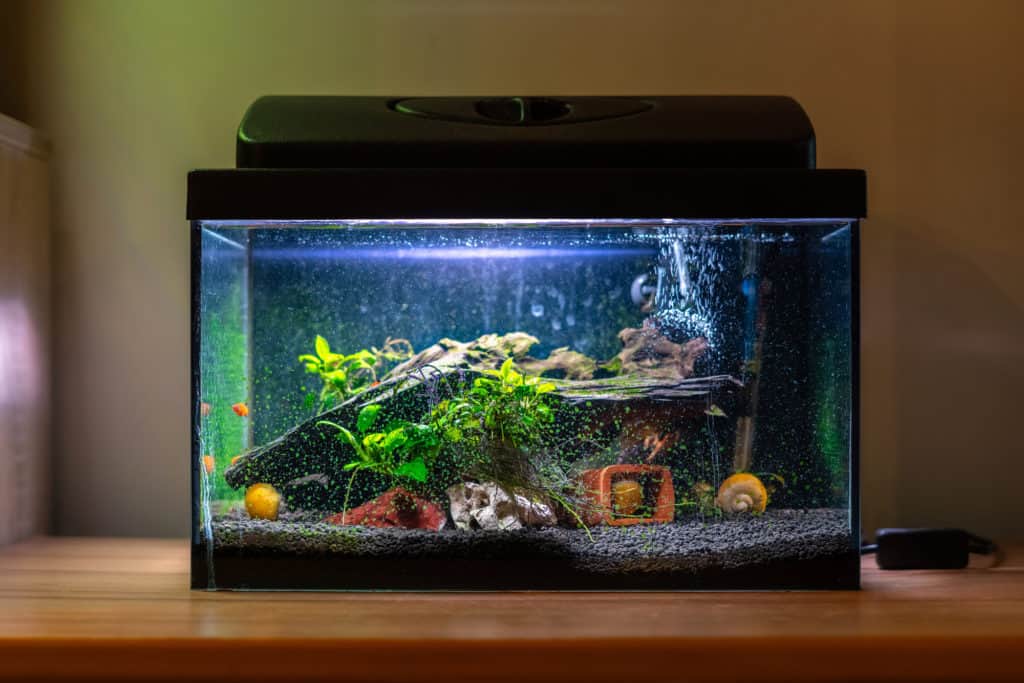
Due to evaporation, the water level in your turtle tank will drop over time. If you fail to top this off using fresh, safe water, then your turtles are at risk of being exposed to hazardous conditions inside their habitat. Not only will this cause your water to turn cloudy, but it could also cause dangerous conditions, such as low oxygen levels or high salinity.
In addition, low water levels can accelerate the buildup of waste and cause disruptions to the cycle process of your turtle tank. This means your turtles will be exposed to higher levels of biochemical stress and may become ill as a result. Under these circumstances, you should restore your tank to its ideal water level to minimize the risk of problems.
The best way to avoid this problem is to use an automatic water top-off system that will prevent your turtle tank from overfilling with water. These systems are relatively inexpensive and can be bought online or at some pet stores. You can also manually top off your turtle tank using distilled or RO-filtered water, but this is a much more time-intensive task.
Introducing Fake Plants To The Tank
Fake plants, plastic decor, and other forms of non-organic decoration can release harmful chemicals into your turtle tank. For example, plastic plants are often treated with harmful chemicals that can cause water cloudiness, along with other dangerous conditions.
One of the best ways to avoid this problem is to use live plants in your turtle tank instead of fake ones. Live plants help keep the water safe for turtles and allow them to feel more at home in their habitat. Fake plants should be replaced with real ones as soon as possible, and all decorations other than gravel should be avoided.
Feeding Too Much Uncooked Vegetable Matter

Many well-meaning turtle owners make the mistake of feeding their turtles too many raw vegetables. This is because vegetables can be a very beneficial part of your turtle’s diet, but you don’t want to overdo it.
Uncooked vegetable matter can cause your turtle tank to cloud up because they rot and release harmful chemicals into the water. This will cause cloudiness and is something that you should avoid at all costs, as these chemicals can make your turtles very sick, if not kill them altogether. In addition, having copious amounts of rotting vegetable matter in your tank will wreak havoc on your tank filter.
The best way to counter this problem is to clean up all uneaten vegetable matter within one day. Place any uneaten food in a plastic bag and store it outside of the turtle tank until you can dispose of it properly so that turtles don’t try to eat it again. You should also never leave food in your turtle tank overnight, even if the turtles have eaten everything they want.
Unvacuumed Gravel
Turtles are messy creatures, which can cause all kinds of problems for their owners. One common issue is the buildup of unvacuumed gravel in a turtle tank. All turtle tanks need a certain amount of gravel to create a natural environment for your turtles. However, many turtle owners fail to account for the effects of gravel on the water quality.
With enough time, unvacuumed gravel will begin to release chemicals into the water, leading to a cloudy tank. This is because the decaying organic material found within gravel produces these chemicals as by-products. Unvacuumed or poorly cleaned gravel can also attract excess
The most obvious solution to this problem is to invest in a gravel vacuum and clean your gravel once per week on a regular basis. You should also change the gravel once every six months or so, depending on how dirty it is. No matter which option you opt for, being conscientious and religious with your tank and gravel cleaning regime will go a long way.
Poor Surface Agitation Of The Water
Surface agitation is the process that brings oxygen into the water and leaves carbon dioxide on top of it. Poor surface agitation can cause water cloudiness because it prevents adequate levels of oxygen from entering the tank. If you have fish in your turtle tank, then surface agitation is especially important because they need oxygen in order to survive.
The best way to counter this problem is to purchase an air stone attachment for the water filter in your tank that will produce better surface agitation and bring more oxygen into the water.
Alternatively, you can purchase an air pump that will increase surface agitation and create a lot more oxygen in the water. Though this option requires more money, it is a surefire way to prevent cloudy turtle tank water.
High Water Temperature
Water that’s too warm can cause bacteria to multiply rapidly, which can make your turtle tank cloudy. A water temperature of 82 degrees Fahrenheit is ideal for turtles because most breeds like to bask in the sun or on heated surfaces when it’s warm outside. This means that warmer water is necessary for your turtle tank to mimic its natural environment.

However, more than 82 degrees Fahrenheit can cause bacteria to grow quickly and can make the water cloudy because of it. This will kill your turtles over time, so you need to keep an eye on the thermometer in your tank at all times. If it starts getting too warm, then you should adjust your water heater or get an aquarium chiller that will reduce the temperature.
Not Changing The Filter Media Often Enough
All filters need filter media, such as activated charcoal or foam, in order to work. If you don’t change this media often enough then it will become dirty and release toxins into the water that cloud it up. Eventually, these toxins can even make your turtles ill and cause them to become very sick or die if left untreated.
The best way to counter this problem is to change the filter media in your turtle tank once every three months or so, depending on how dirty it gets. This will remove all of the toxins that are constantly released into the water and prevent cloudiness from occurring. If you don’t do this, then you’re risking your turtles becoming sick over time because of the toxic water.
Infrequent Filter Cleanings
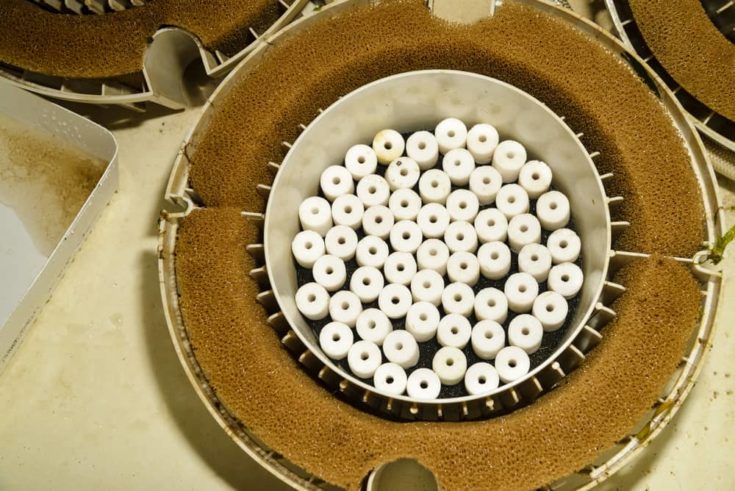
Right next to failing to change the filter media often enough, infrequent filter cleanings are one of the most common causes of turtle tank water cloudiness. It doesn’t matter if you own a powerful filter or a small one, if you don’t clean it then the water is going to become dirty and cloudy.
The best way to counter this problem is to start cleaning filters on a weekly basis or as soon as the flow of the stream becomes weak. If you wait too long to clean it, then waste matter will start accumulating in your filter pads or media, which will cloud up your tank.
Remember – a dirty tank filter is no different than having one that’s not there at all. It won’t function optimally and will just cause problems for your turtles over time, so be vigilant about filter cleanings and stick to a good filter maintenance schedule. You’ll be glad that you did.
Preventive Measures
Now that we’ve gone over some of the most common causes for cloudy turtle tank water, let’s take a look at how you can prevent them from occurring. Prevention is always the best form of cure, so learn about some ways that you can keep your tank looking crystal clear at all times.
Keep Your Tank Water Clean
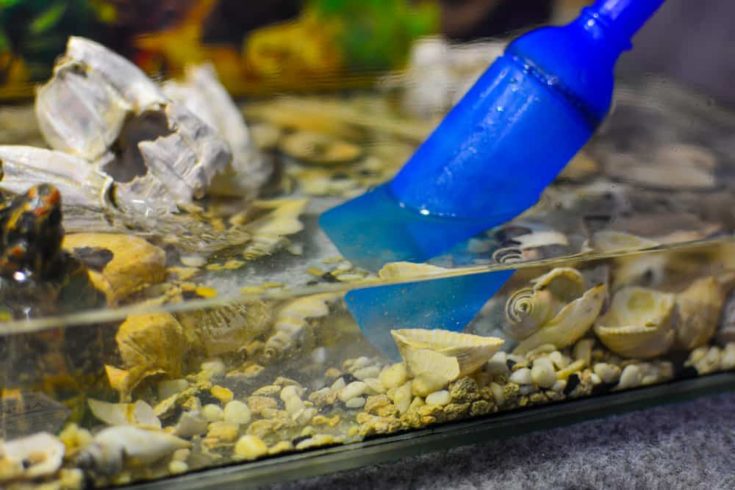
This may sound obvious, but having clean water in your tank at all times is one of the best ways of keeping cloudiness at bay. The simplest and most intuitive way to accomplish this is by conducting frequent water changes. Daily water changes are the most effective way to go, but you can usually go three days or so before needing to replace it again.
If you’ve been dealing with brown water on top of having a dirty tank, you will also need to invest in a good aquarium vacuum to suck up all of that muck before it causes problems for your turtles. A turtle aquarium vacuum is inexpensive and easy to use, so there’s no reason not to have one at your disposal.
Finally, you should take advantage of multiple filtration methods to maintain a clean tank. Mechanical filtration, such as a turtle tank filter, will remove all of the waste particles that can cause cloudy tank water. Biological filtration, on the other hand, will remove all of that nitrate and ammonia that can cause cloudy water over time.
The more filtration methods you use, the cleaner your tank water will remain on a daily basis. This is arguably one of the most effective ways to keep the turtle tank water clean because it will stop any sort of bacteria or contaminants from accumulating in your aquarium.
Use A Water Conditioner
Using a quality water conditioner is one of the easiest and cheapest ways to keep your tank looking good in between water changes. While you should always do a filter cleaning and replace any old filter media when doing a water change, this will only take care of half of the filtration process.
Water conditioners, on the other hand, manipulate the chemistry of water in a way that will make it safe for your turtles to live in. If you live in an area with chlorine-treated water, water conditioners can eliminate that for you in a matter of minutes, instead of making you wait for a couple of days for chlorinated water to dissipate.
One thing to note is you should always steer clear of cheap water conditioners. Think about it – water conditioners don’t just make dechlorinated water, they also alter water chemistry in a way that’s better for turtles. So why would you settle for something low-quality? You may still find yourself with cloudy water tanks at the end of the day, or worse still, your turtles may get sick.
Introduce Beneficial Bacteria Into Your Turtle’s Habitat
I know that the idea of introducing a bacteria colony into your tank may sound risky at first, but there are actually certain “good” bacteria that will eliminate waste matter in your aquarium. These beneficial nitrification bacteria attach to surfaces where they feed on organic material for between one and three weeks before multiplying to a point of being able to handle all waste matter in your fish tanks.
Bacterial colonization requires patience, but if you’re willing to wait for their proliferation then you will find that cloudy turtle tank water becomes a thing of the past. Not only will it reduce cloudiness in tank water, but it can also give your pets a consistent water quality that is free of any harmful bacteria or foul odors.
At the end of the day, effective nitrogen cycling and regular water changes play major roles in keeping bad water quality at bay. By introducing the proper types of bacteria, you will make sure that your turtles can thrive in their habitat without having to worry about any sort of contaminants polluting their home.
Conclusion
So, why is your turtle tank cloudy? We hope this article helped you figure out the answer to that question. By investing in high-quality filtration, water conditioners, and bacteria colonies, you’ll be able to keep your turtle’s habitat looking great. The best part? You’ll have a happy and healthy pet on your hands – and that’s the best feeling of all!
As always, if you have any questions about this article or are having an issue with your turtle tank, please leave us a comment below. We would love to hear from you, and we’ll do our best to help you out!
